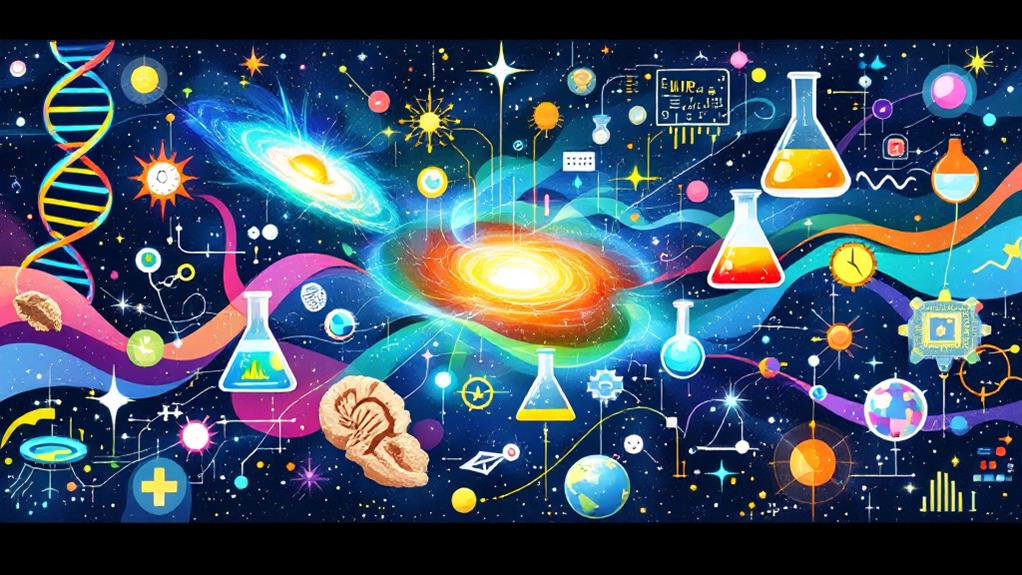The God Particle – Higgs Boson: What Is It and Why Is It Significant?

You might wonder why the Higgs Boson, often called the 'God Particle,' is significant. It's essential because it explains how particles get their mass through the Higgs Field. Without it, particles would zoom around at light speed, and the universe couldn't form as we understand it. The Higgs mechanism, proposed in the 1960s, fills an important gap in the Standard Model of particle physics. Its revelation in 2012 at the Large Hadron Collider confirmed this theory, transforming our comprehension of the universe. This particle's story is far from over and continues to push the boundaries of modern physics.
Understanding the Higgs Field
Imagine a universe where particles are racing around without mass, a chaotic dance with no order. That's where the Higgs mechanism comes into play, introducing a field that permeates the universe, providing particles with mass. You're diving into the Higgs Field, a cornerstone of field theory. It's the invisible fabric enabling mass generation through particle interactions.
At the heart of this field are quantum fluctuations that cause the Higgs Field to fluctuate, even in a vacuum. These fluctuations are significant as they lead to symmetry breaking, a process that guarantees particles acquire mass. Without this, particles would remain massless, forever zipping through space at the speed of light.
As you investigate particle interactions within the Higgs Field, you'll see how they slow down, gaining mass and forming the universe as we understand it. This process is fundamental for comprehending how the universe transformed from chaos to order. The Higgs mechanism is not just theoretical; it's a practical framework explaining how particles gain mass. This complex dance of quantum fluctuations and symmetry breaking is critical to the structure of our universe. Understanding the Higgs Field means understanding the universe's fundamental nature.
Theoretical Origins of the Higgs Boson
As you investigate the Higgs Field's role in mass generation, it is crucial to understand the theoretical origins of the Higgs Boson, the particle associated with this field. In the 1960s, theoretical physicists sought to solve a fundamental problem in particle physics: explaining how particles acquire mass. The framework of quantum mechanics, which governs the behavior of particles at the smallest scales, didn't initially account for this. Enter the Higgs mechanism, proposed independently by several physicists, including Peter Higgs.
This mechanism introduced the idea of a universal field, later known as the Higgs Field, permeating the entire universe. As particles interact with this field, they gain mass, similar to how a swimmer pushes through water and feels resistance. The Higgs Boson itself is an excitation of this field, fundamentally a ripple that confirms its existence.
In particle physics, this concept was revolutionary. It provided a missing piece for the Standard Model, which describes the fundamental forces and particles of the universe. Without the Higgs mechanism and its associated boson, the Standard Model couldn't explain why some particles have mass while others, like photons, don't. Understanding this origin is key to grasping the broader implications of the Higgs Boson.
Discovery at the Large Hadron Collider

In 2012, the world of particle physics celebrated a monumental achievement with the finding of the Higgs Boson at the Large Hadron Collider (LHC) in Switzerland. This revelation was the result of years of careful LHC experiments that smashed particles together at incredibly high energies. These particle collisions allowed scientists to investigate conditions similar to those just after the Big Bang, leading to breakthrough revelations.
The success at the LHC was a confirmation of scientific collaboration, with thousands of researchers from around the globe working tirelessly. They faced numerous experimental challenges, from designing sensitive detection methods to handling the massive volumes of data generated. The physics community had to employ sophisticated data analysis techniques to sift through this data and identify the elusive Higgs Boson.
Detection methods involved pinpointing the Higgs among countless other particles produced in the collisions. This required cutting-edge approaches and precision instruments capable of capturing fleeting particle interactions. The announcement of the Higgs Boson's finding was a triumph not only for those directly involved but for the entire scientific community. It marked a significant milestone in our understanding of the universe, proving the power of international collaboration and determination.
Role in the Standard Model
Building on the monumental finding at the Large Hadron Collider, the Higgs Boson plays an important role in the Standard Model of particle physics. It helps explain how particles acquire mass, thanks to a process known as the Higgs mechanism. Imagine the universe as a quantum field that permeates everything. The Higgs field is a part of this intricate tapestry, and when particles interact with it, they gain mass. This mass generation is vital because it allows particles to form the building blocks of matter.
The Higgs Boson is also significant for particle interactions and maintaining the balance of fundamental forces. Before the Higgs mechanism kicks in, particles are massless and the universe exhibits a kind of symmetry. However, the Higgs Boson introduces symmetry breaking, an important step that differentiates the weak nuclear force from electromagnetism. This distinction allows the forces to function distinctly and effectively.
Implications for Modern Physics

The finding of the Higgs Boson has transformed our understanding of modern physics, opening new avenues for exploration and findings. By providing experimental validation of the Higgs field, it has clarified how particles acquire mass through mass generation. This revelation is essential in understanding quantum mechanics and particle interactions at the most fundamental level. It also plays a significant role in the symmetry breaking process, which differentiates the fundamental forces of nature. You witness how this breakthrough supports the Standard Model, confirming theories that were once speculative.
Moreover, the implications extend beyond theoretical physics. The Higgs Boson has astrophysical relevance, offering insights into the evolution of the universe and the behavior of celestial bodies. It helps explain the conditions that emerged after the Big Bang, vital for understanding the cosmos. Regarding technological applications, the research conducted at facilities like CERN has led to advancements in data processing, medical imaging, and even internet technologies. By grasping how the Higgs Boson fits into the larger picture of physics, you're not just witnessing a milestone in science, but a catalyst for innovation and a deeper comprehension of the universe's hidden mechanisms.
Future Research and Exploration
With the revelation of the Higgs Boson, future research and investigation are poised to plunge deeper into the mysteries of the universe. You're on the brink of understanding quantum fluctuations like never before. Collider experiments will push the boundaries, enabling you to observe particle interactions at unprecedented energy scales. As you probe into these minute processes, you'll uncover insights that could redefine our comprehension of new physics and the fundamental forces that govern our reality.
One key area of inquiry is dark matter, an elusive component of the cosmos. By experimenting with creative experimental techniques, you may ultimately illuminate its nature and cosmic implications. The Higgs Boson offers a doorway to these mysteries, signaling potential breakthroughs in understanding how dark matter interacts with known particles.
Moreover, your expedition doesn't stop there. The search for new phenomena beyond the Standard Model will lead you to investigate energy scales previously thought unreachable. As you refine collider experiments and develop cutting-edge detectors, you'll inch closer to unearthing the secrets of the universe. This ongoing quest promises to transform our grasp of the cosmos and fuel scientific advancement for generations to come.



